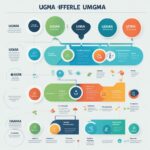As a self-employed individual or business owner with no employees, you have likely heard of the solo 401(k) plan as a valuable retirement savings tool. But what are the contribution limits for this unique retirement plan? In this article, I will explain the solo 401(k) contribution limits for 2024 and beyond, helping you plan for a secure financial future.
The contribution limits for a solo 401(k) plan are determined by both employee and employer contributions. For 2024, the maximum elective deferral contribution is $19,500, with an additional catch-up contribution of $6,500 for individuals aged 50 or older. This means that if you are eligible, you can contribute up to $27,000 as an employee.
But that’s not all. As the employer, you can make a nonelective contribution of up to 25% of your compensation or net earnings from self-employment. These employer contributions can add significant value to your retirement savings strategy.
It’s important to note that the total contributions to a solo 401(k) plan, excluding catch-up contributions for individuals aged 50 and older, cannot exceed $58,000 for 2024. However, these contribution limits are subject to change each year, so it’s essential to stay updated with the latest guidelines.
Key Takeaways:
- The solo 401(k) plan is a self-employed retirement plan with both employee and employer contributions.
- The maximum employee contribution for 2024 is $19,500 ($27,000 for individuals aged 50 or older).
- As the employer, you can make a nonelective contribution of up to 25% of compensation or net earnings from self-employment.
- The total contributions to a solo 401(k) plan, excluding catch-up contributions, cannot exceed $58,000 in 2024.
- Stay updated with the latest contribution limits to maximize your retirement savings.
Understanding Solo 401k Plans
A solo 401(k) plan, also known as an individual 401(k) or a one-participant 401(k), is a retirement savings plan designed for self-employed individuals or business owners with no employees other than themselves and their spouses. It operates like a traditional 401(k) plan but with specific rules and requirements tailored to the unique needs of self-employed individuals.
Solo 401(k) plans offer higher contribution limits and flexibility in investment options compared to other retirement plans. This allows self-employed individuals to save more for their future while also enjoying the tax advantages of a 401(k) plan. With a solo 401(k), you have control over your retirement savings and can customize your investment strategy to align with your financial goals.
Benefits of Solo 401k Plans:
- Higher Contribution Limits: Solo 401(k) plans allow you to contribute more to your retirement savings compared to other retirement plans. As both the employer and employee, you can make both elective deferrals and employer contributions to maximize your savings.
- Tax Advantages: Contributions to a solo 401(k) plan are typically tax-deductible, reducing your taxable income for the year. Additionally, the earnings within the plan grow on a tax-deferred basis, allowing your investments to compound over time.
- Investment Flexibility: Solo 401(k) plans provide a wide range of investment options, including stocks, bonds, mutual funds, and real estate. This flexibility allows you to diversify your portfolio and potentially increase your investment returns.
- Retirement Savings Security: By taking advantage of the higher contribution limits and tax advantages of a solo 401(k) plan, you can build a substantial retirement nest egg. This provides greater financial security and the ability to enjoy a comfortable retirement.
To fully understand the benefits and potential drawbacks of a solo 401(k) plan, it’s important to consult with a financial professional who can provide personalized advice based on your specific circumstances and goals. With their expertise, you can make informed decisions about your retirement savings and ensure that you’re making the most of your solo 401(k) plan.
Key Takeaways:
- Solo 401(k) plans are retirement savings plans designed for self-employed individuals.
- These plans offer higher contribution limits and greater investment flexibility compared to other retirement plans.
- Contributions to a solo 401(k) plan are tax-deductible, and earnings grow on a tax-deferred basis.
- Consulting with a financial professional is essential for maximizing the benefits of a solo 401(k) plan and ensuring a secure retirement.
Contribution Limits for Solo 401k Plans
When it comes to solo 401(k) plans, the contribution limits are determined by two key factors: elective deferrals (employee contributions) and employer nonelective contributions. Let’s take a closer look at these limits to understand how much you can contribute to your solo 401(k) plan.
Elective Deferral Contributions
As a self-employed individual, you can make elective deferrals to your solo 401(k) plan. For the year 2024, the maximum amount you can contribute is $19,500. However, if you are 50 years or older, you have the opportunity to make catch-up contributions of up to $27,000. These catch-up contributions are designed to help individuals accelerate their retirement savings as they near retirement age.
Employer Nonelective Contributions
In addition to elective deferrals, you can also make employer nonelective contributions to your solo 401(k) plan. These contributions are calculated as a percentage of your compensation or net earnings from self-employment. The maximum amount you can contribute as an employer nonelective contribution is 25% of your compensation or net earnings from self-employment.
It’s important to note that the combined total of your elective deferrals and employer nonelective contributions cannot exceed $58,000 for the year 2024. This maximum limit is subject to change each year, so it’s crucial to review the contribution limits annually to ensure compliance.
By understanding the contribution limits for solo 401(k) plans, you can make informed decisions about how much to contribute to your retirement savings. It’s recommended to consult with a financial professional to determine the optimal contribution strategy based on your individual circumstances and retirement goals.

Summary:
- The maximum elective deferral contribution for 2024 is $19,500, or $27,000 for individuals 50 years or older.
- Employer nonelective contributions can be up to 25% of compensation or net earnings from self-employment.
- The combined total of elective deferrals and employer nonelective contributions cannot exceed $58,000 for 2024.
- Annual review of contribution limits is important as they can change each year.
Contribution Limits for Self-Employed Individuals
As a self-employed individual contributing to a solo 401(k) plan, it’s crucial to understand the special computation required to determine your maximum allowable contribution. This computation takes into account your earned income, which is defined as your net earnings from self-employment after subtracting half of the self-employment tax and contributions made for yourself.
In order to calculate your allowable contribution rate and tax deduction, you can refer to the rate table or worksheets provided in IRS Publication 560. This resource will guide you through the necessary calculations, ensuring that you are maximizing your contributions to your solo 401(k) plan.
Understanding these computations is essential for self-employed individuals like yourself, as it enables you to take full advantage of the contribution limits specific to your situation. By being knowledgeable about these calculations, you can make informed decisions and strategically plan your contributions to optimize your retirement savings.
In summary, if you’re self-employed and contributing to a solo 401(k) plan, be sure to familiarize yourself with the earned income computation and the IRS guidelines provided in Publication 560. Utilize these resources to determine the maximum allowable contribution and tax deduction that align with your financial goals.
Benefits of Understanding Self-Employed Contribution Limits
By understanding the intricacies of self-employed 401(k) contribution limits, you can:
- Demystify the calculation process for your maximum allowable contributions
- Optimize your retirement savings by maximizing your contributions
- Take advantage of the potential tax deductions offered by these contributions
- Confidently plan your retirement strategy by leveraging the unique benefits of self-employed retirement plans
Equipped with this knowledge, you can navigate the contribution limits for self-employed individuals and make informed decisions that align with your long-term financial objectives.

Nondiscrimination Testing for One-Participant 401k Plans
One of the advantages of a one-participant 401(k) plan, such as a solo 401(k), is that it doesn’t require nondiscrimination testing if there are no employees who could have received disparate benefits. However, if I hire employees who meet the plan eligibility requirements, I must include them in the plan, and their elective deferrals will be subject to nondiscrimination testing.
This testing ensures that the plan doesn’t disproportionately favor highly compensated employees. It aims to prevent a scenario where highly paid employees receive significantly greater benefits compared to lower-paid employees. By conducting this testing, the IRS ensures fairness and compliance with the rules.
If eligible employees were mistakenly excluded from the plan, steps should be taken to correct this error. Rectifying such omissions will help maintain compliance and prevent potential penalties. It is essential to consult with a tax professional or retirement plan consultant to ensure proper adherence to nondiscrimination testing requirements.
Filing Requirements for One-Participant 401k Plans
When it comes to one-participant 401(k) plans, understanding the filing requirements is essential to ensure compliance with IRS regulations. These filing requirements help maintain the integrity of the retirement plan and provide transparency for plan participants. In this section, I will provide an overview of the filing requirements for one-participant 401(k) plans and discuss the importance of Form 5500-EZ.

Annual Report on Form 5500-EZ
One-participant 401(k) plans generally need to file an annual report on Form 5500-EZ with the IRS. This form serves as a summary of the plan’s financial activity and ensures that the plan is operating within the guidelines set by the Internal Revenue Code. Filing Form 5500-EZ allows the IRS to monitor the plan and ensure compliance with the filing requirements.
However, not all one-participant 401(k) plans are required to file Form 5500-EZ. The filing requirement is based on the plan’s total assets at the end of the year. If the plan has $250,000 or more in assets, it must file Form 5500-EZ. On the other hand, if the plan has fewer assets, it may be exempt from the annual filing requirement.
The Importance of Form 5500-EZ
Form 5500-EZ plays a crucial role in maintaining the transparency and regulatory compliance of one-participant 401(k) plans. By filing this form annually, plan sponsors demonstrate their commitment to following the rules and regulations set by the IRS. It also ensures that the plan’s participants have access to information about the plan’s financial activities and can make informed decisions regarding their retirement savings.
Filing Form 5500-EZ helps protect the interests of plan participants and ensures that the plan remains in good standing with the IRS. It also serves as a valuable record-keeping tool for plan sponsors and provides valuable information for any future audits or inquiries from the IRS.
Consult IRS Guidelines
Business owners with one-participant 401(k) plans should consult the IRS guidelines to understand their specific filing requirements. The IRS provides detailed instructions and resources to help plan sponsors navigate the filing process and ensure compliance. It’s important to review these guidelines regularly as they may change over time.
| Filing Requirement | Assets at the End of the Year |
|---|---|
| File Form 5500-EZ | $250,000 or more |
| Exempt from Annual Filing | Less than $250,000 |
By understanding and fulfilling the filing requirements for one-participant 401(k) plans, business owners can ensure compliance with IRS regulations and maintain the integrity of their retirement plans. Consulting the IRS guidelines and filing Form 5500-EZ in a timely manner is essential for the successful administration of a one-participant 401(k) plan.
Alternatives to One-Participant 401k Plans
While a one-participant 401(k) plan is a popular choice for self-employed individuals, there are alternative retirement plans available. For those looking for options beyond a solo 401(k), consider exploring the following alternatives:
Simplified Employee Pension (SEP) IRA
An SEP IRA is another retirement plan option for self-employed individuals. It allows for higher contribution limits compared to a traditional or Roth IRA, offering the potential for greater retirement savings. Contributions to an SEP IRA are made solely by the employer, and tax benefits can be significant.
Traditional and Roth IRAs
Traditional and Roth IRAs are individual retirement accounts that can be suitable for self-employed individuals. Traditional IRAs offer tax-deferred savings, while Roth IRAs provide tax-free withdrawals in retirement. Both plans have contribution limits and income eligibility requirements that should be considered.
When exploring these alternatives, it’s important to evaluate your specific needs, retirement goals, and financial circumstances. Consulting with a financial professional can provide valuable guidance in selecting the most suitable retirement plan for your self-employed journey.

The Benefits of Solo 401k Contribution Limits
The high contribution limits of a solo 401(k) plan make it an attractive option for self-employed individuals. As a solo 401(k) participant, I have personally experienced the advantages of these contribution limits. Let me share with you the key benefits of solo 401k contribution limits:
- Greater Flexibility: The ability to contribute both as an employee and an employer allows me to tailor my retirement savings strategy to my unique financial situation. I have the freedom to decide how much I want to contribute as an employee and how much I can contribute as an employer.
- Opportunity to Maximize Retirement Savings: With higher contribution limits compared to other retirement plans, solo 401(k) allows me to potentially save a larger percentage of my income in a tax-advantaged account. This means I can set aside more money for my retirement, which can lead to substantial savings over time.
- Tax Advantages: Solo 401(k) contributions are made on a pre-tax basis, which helps to lower my taxable income. By reducing my taxable income, I can potentially pay less in taxes and keep more of my hard-earned money for retirement.
The combination of these benefits makes solo 401(k) contribution limits a powerful tool for self-employed individuals like myself. By taking advantage of these contribution limits, I am able to build a more secure financial future and work towards a comfortable retirement.
As a self-employed individual, I highly recommend considering a solo 401(k) plan for its contribution limits and the flexibility it offers. The opportunity to maximize retirement savings, coupled with the tax advantages, make solo 401(k) plans a valuable asset for anyone looking to secure their financial future.
The Importance of Maxing Out Solo 401k Contributions
Maximizing solo 401(k) contributions is a crucial step for self-employed individuals looking to secure their financial future. By contributing the maximum allowable amount each year, you can take full advantage of the tax benefits and the potential growth of your retirement savings.
Why is it important to maximize your solo 401(k) contributions?
- Tax benefits: By contributing the maximum amount, you can reduce your taxable income for the year. This means you’ll owe less in taxes, ultimately saving you money.
- Potential growth: The more you contribute, the more your retirement savings have the potential to grow over time. By maximizing your contributions, you’re giving your savings the opportunity to benefit from compounding interest and investments.
- Comfortable retirement: The primary goal of saving for retirement is to ensure a comfortable lifestyle once you stop working. By maxing out your contributions, you’re increasing the likelihood of having enough savings to support your desired retirement lifestyle.
- Financial safety net: Life is full of surprises, and having a substantial retirement savings can act as a safety net for unexpected expenses or emergencies in the future. Maxing out your contributions helps build a strong financial foundation for whatever lies ahead.
Remember, the solo 401(k) contribution limits are designed to provide self-employed individuals with the opportunity to save more for retirement. Taking advantage of these limits is a proactive step towards achieving your long-term financial goals.
By prioritizing retirement savings and maximizing your solo 401(k) contributions, you’re setting yourself up for a brighter and more secure financial future.
Look at the table below to visualize the potential growth of retirement savings when maximizing solo 401(k) contributions:
| Years of Contributions | Total Contributions | Estimated Earnings (6% annual return) | Final Balance |
|---|---|---|---|
| 10 | $195,000 | $146,776 | $341,776 |
| 20 | $390,000 | $563,680 | $953,680 |
| 30 | $585,000 | $1,295,490 | $1,880,490 |
Maximizing solo 401(k) contributions can lead to significant growth in retirement savings over time.
Planning for Future Contribution Limit Increases
Solo 401(k) contribution limits are not set in stone and can change from year to year. It’s important for self-employed individuals like me to stay informed about upcoming changes in contribution limits to make informed decisions about retirement savings. By anticipating future contribution limit increases, I can continue to maximize my savings and take advantage of new opportunities for tax-advantaged retirement planning.
I understand that staying updated on contribution limit changes requires regular research and monitoring. I can consult reliable sources such as the Internal Revenue Service (IRS) or reputable financial publications for the latest information. Additionally, engaging the services of a financial professional who specializes in retirement planning can provide valuable insights and guidance.
Having a solid understanding of future contribution limit changes allows me to adjust my retirement savings strategy accordingly. By planning ahead, I can make any necessary adjustments to my budget or financial goals to ensure I maximize my savings within the new limits.
Adapting to Changing Contribution Limits
When contribution limits increase, I can take advantage of the opportunity to contribute more to my solo 401(k) plan. This allows me to potentially save a larger percentage of my income in a tax-advantaged account, which can lead to substantial growth over time.
However, it’s important to note that an increase in contribution limits also means reassessing my financial situation and determining whether increasing my contributions is feasible. I need to consider factors such as my cash flow, expenses, and other financial commitments to make an informed decision.
Furthermore, understanding future contribution limit increases enables me to explore alternative retirement savings options. If the new limits no longer align with my financial goals or circumstances, I can evaluate other retirement plans that may offer better flexibility or benefits for my situation.
In summary, planning for future contribution limit increases is crucial for self-employed individuals to optimize their retirement savings. By staying informed, seeking professional guidance, and adapting to changing limits, I can continue to make the most of my solo 401(k) plan and work towards a secure financial future.
| Year | Elective Deferral Contribution Limit | Employer Nonelective Contribution Limit | Total Contribution Limit (Excluding Catch-up Contributions) |
|---|---|---|---|
| 2020 | $19,500 | 25% of compensation or net earnings from self-employment | $57,000 |
| 2024 | $19,500 | 25% of compensation or net earnings from self-employment | $58,000 |
| 2024 (estimated) | $20,000 | 25% of compensation or net earnings from self-employment | TBD |
The Power of Compound Interest and Solo 401k Contributions
The path to building a secure retirement begins with understanding the power of compound interest and the benefits of long-term savings. When it comes to retirement planning for self-employed individuals, the growth of solo 401k contributions can be a game-changer.
Compound interest is a magical phenomenon that allows your retirement savings to grow exponentially over time. It’s like a snowball rolling down a hill, gathering momentum and increasing in size as it goes. The more time you have to contribute to your solo 401(k) plan and let those contributions accumulate and compound, the greater the potential for substantial wealth in retirement.
Consistent savings is key. By prioritizing regular contributions to your solo 401(k) plan, you are setting yourself up for long-term financial success. This disciplined approach ensures that you take full advantage of the benefits that compound interest offers. Even small contributions made consistently over time can lead to significant growth in your retirement savings.
Imagine this: you start contributing to your solo 401(k) plan in your 30s and continue for several decades. By the time you reach retirement age, your contributions, combined with the power of compound interest, have multiplied many times over. This can provide you with a comfortable retirement and the financial security you deserve.
“Compound interest is the eighth wonder of the world. He who understands it, earns it; he who doesn’t, pays it.” – Albert Einstein
Remember, the longer your contributions have to grow, the greater the potential for exponential growth through compound interest. By consistently saving for retirement and allowing compound interest to work its magic, you can set yourself on a path to financial independence and a worry-free retirement.
Benefits of Compound Interest and Long-Term Savings
The benefits of compound interest and long-term savings extend beyond the growth of your solo 401(k) contributions. Here are a few key advantages:
- Accelerated growth: The power of compound interest allows your retirement savings to grow faster over time, thanks to the compounding effect on both your contributions and the returns on your investments.
- Time advantage: Starting early and contributing regularly gives you a significant advantage, as time allows your investments to weather short-term market fluctuations and benefit from long-term market growth.
- Financial security: By consistently saving for retirement, you are building a secure financial future. Compound interest helps you accumulate wealth, providing a safety net in your later years.
It’s worth noting that compound interest is not limited to solo 401(k) plans. The concept applies to all types of investment accounts and can be leveraged to benefit your financial goals.
Make Compound Interest Work for You
To tap into the power of compound interest, it’s important to start saving early and remain consistent. Make it a habit to contribute to your solo 401(k) plan regularly, even if the contributions start small. Over time, the compounding effect will work its magic and help you achieve your retirement savings goals.
Here are a few tips to maximize the benefits of compound interest:
- Automate your contributions: Set up automatic contributions to your solo 401(k) plan, ensuring that you save consistently without the need for constant manual intervention.
- Take advantage of catch-up contributions: If you’re aged 50 or older, you can make additional catch-up contributions to your solo 401(k) plan, allowing you to potentially accelerate the growth of your retirement savings.
- Diversify your investments: By diversifying your investments within your solo 401(k) plan, you can spread the risk and potentially enhance your long-term returns.
By combining the benefits of compound interest with the flexibility and growth potential of solo 401(k) contributions, you can pave the way for a financially secure retirement.
The Deadline for Solo 401k Contributions
As a self-employed individual, it’s crucial to understand the deadline for making solo 401(k) contributions. This deadline varies depending on the specific business type and the due date of your business tax return. Being aware of these contribution deadlines is essential to maximize the benefits of your solo 401(k) plan and effectively plan for your retirement.
Let’s break it down:
Employee Contributions
For employee contributions, you typically have until the tax filing deadline for the year to make your contributions. This deadline aligns with the deadline for filing your personal tax return, which is usually April 15th. However, it’s important to note that if you file for an extension, you have until the extended due date to make your contributions.
Employer Contributions
On the other hand, employer contributions must be made by the end of the calendar year. This means that if you want to make employer contributions for a specific tax year, you must ensure they are made before December 31st of that year.
Understanding these contribution deadlines is crucial for effective retirement planning. Missing the deadlines could mean losing out on valuable tax advantages and the opportunity to maximize your retirement savings. Be sure to mark these dates on your calendar and take action in a timely manner.
Remember, the overall contribution deadline for a self-employed individual is the tax filing deadline or the extended due date, whichever comes first. However, employer contributions have a separate deadline of December 31st of the applicable tax year.
Make sure you consult with a financial professional or tax advisor to ensure you comply with the deadlines and make the most of your solo 401(k) plan.
Conclusion
In conclusion, solo 401(k) contribution limits provide self-employed individuals with an excellent opportunity to maximize their retirement savings and enjoy tax-advantaged retirement planning. By understanding and staying updated on the contribution limits, planning for future increases, and making consistent contributions, individuals can build a solid financial foundation for their retirement years.
It is crucial for self-employed individuals to consult with a financial professional to receive personalized guidance and make the most of their solo 401(k) plan. A financial advisor can help navigate the complexities of retirement planning and ensure that contributions align with long-term goals.
Lastly, it’s important to remember the power of compound interest and the impact of consistent savings. By starting early and consistently contributing to a solo 401(k) plan, individuals can leverage the potential growth of their retirement savings over time, leading to a secure and comfortable retirement lifestyle.
FAQ
What are the contribution limits for a solo 401(k) plan?
The contribution limits for a solo 401(k) plan depend on both employee and employer contributions. For 2024, the maximum elective deferral contribution is ,500 (,000 for individuals aged 50 or older), and the employer nonelective contribution can be up to 25% of compensation or net earnings from self-employment. The total contributions to a solo 401(k) plan, excluding catch-up contributions, cannot exceed ,000 for 2024. These limits may change each year.
What is a solo 401(k) plan?
A solo 401(k) plan, also known as an individual 401(k) or one-participant 401(k), is a retirement account designed for self-employed individuals or business owners with no employees. It offers higher contribution limits and investment flexibility compared to other retirement plans.
What are the contribution limits for self-employed individuals?
Self-employed individuals can contribute up to ,500 in 2024 (,000 if age 50 or older) as elective deferrals to their solo 401(k) plan. Additionally, the employer nonelective contributions can be up to 25% of compensation or net earnings from self-employment. The total contributions, including both employee and employer contributions, cannot exceed ,000 for 2024.
What is nondiscrimination testing for one-participant 401(k) plans?
Nondiscrimination testing ensures that a solo 401(k) plan doesn’t disproportionately favor highly compensated employees. If a business owner hires eligible employees, their elective deferrals will be subject to this testing. It is important to include eligible employees in the plan and correct any exclusion errors.
Are there filing requirements for one-participant 401(k) plans?
One-participant 401(k) plans generally need to file an annual report on Form 5500-EZ if the plan’s assets exceed 0,000 at the end of the year. However, smaller plans may be exempt from this filing requirement. It is important to be aware of the filing obligations and consult IRS guidelines for more information.
What are the alternatives to one-participant 401(k) plans?
Self-employed individuals can consider Simplified Employee Pension (SEP) IRAs or traditional/Roth IRAs as alternatives to one-participant 401(k) plans. These plans have their own contribution limits and requirements that should be considered based on individual needs.
What are the benefits of solo 401(k) contribution limits?
Solo 401(k) contribution limits allow self-employed individuals to maximize their retirement savings and take advantage of tax-advantaged retirement planning. The higher contribution limits compared to other plans offer the opportunity to save a larger percentage of income in a tax-advantaged account.
Why is it important to max out solo 401(k) contributions?
Maxing out solo 401(k) contributions allows self-employed individuals to fully utilize tax benefits and potential growth of their retirement savings. It helps ensure a comfortable retirement lifestyle and provides a financial safety net in later years.
How can one plan for future contribution limit increases?
Staying informed about upcoming changes in solo 401(k) contribution limits is crucial. Planning for future increases helps individuals maximize their savings and take advantage of new opportunities for tax-advantaged retirement plans.
What is the significance of compound interest and solo 401(k) contributions?
Consistently contributing to a solo 401(k) plan and allowing the contributions to accumulate and compound over time can lead to significant wealth in retirement. The longer the contributions have to grow, the greater the potential for exponential growth through compound interest.
What is the deadline for solo 401(k) contributions?
The deadline for solo 401(k) contributions depends on the business type and the due date of the business tax return. Employee contributions can usually be made until the tax filing deadline, while employer contributions must be made by the end of the calendar year.
What are the key takeaways on solo 401(k) contribution limits?
Solo 401(k) contribution limits provide self-employed individuals with the opportunity to maximize retirement savings and take advantage of tax-advantaged retirement planning. It is important to understand the contribution limits, plan for the future, and consult with financial professionals for personalized guidance.
Our Friends
- https://www.irs.gov/retirement-plans/one-participant-401k-plans
- https://www.mysolo401k.net/solo-401k/solo-401k-contribution-limits-and-types/
- https://www.fool.com/retirement/plans/solo-401k/contribution-limits/
Money posts:
 Solo 401k Rules for Your Self-Employed Retirement Plan (2024)
Solo 401k Rules for Your Self-Employed Retirement Plan (2024)
 What are the 401(k) Contribution Limits for? (2024)
What are the 401(k) Contribution Limits for? (2024)
 Welcome to W-4 Form: What It Is & How to Fill It Out!
Welcome to W-4 Form: What It Is & How to Fill It Out!
 What Is Compound Interest? | Make Money Doing Nothing
What Is Compound Interest? | Make Money Doing Nothing
 UGMA vs. UTMA: What’s the Difference?
UGMA vs. UTMA: What’s the Difference?
 What’s the Difference Between Financial Freedom and Financial Independence in 2024?
What’s the Difference Between Financial Freedom and Financial Independence in 2024?
 What Are the Different Types of Financial Advisors? (2024)
What Are the Different Types of Financial Advisors? (2024)
 The Space of Freedom with Vicki Robin (2024)
The Space of Freedom with Vicki Robin (2024)

